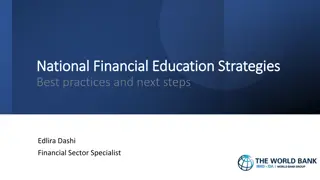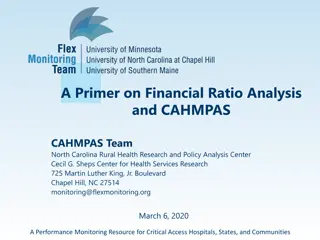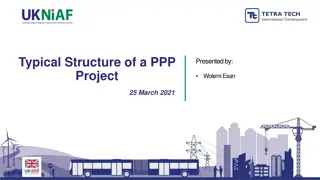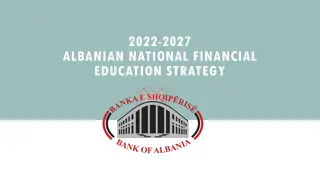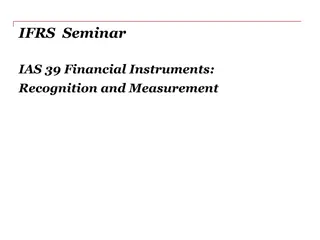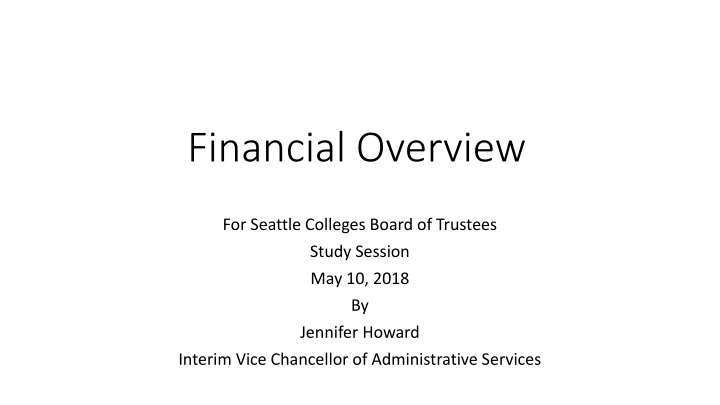
Seattle Colleges Financial Overview for Board of Trustees Study Session May 10, 2018
Explore the financial overview presented to the Seattle Colleges Board of Trustees regarding operating budgets, state allocations, local funds, reserves, and policy reserves. Gain insights into how funds are distributed and managed within the college system.
Download Presentation

Please find below an Image/Link to download the presentation.
The content on the website is provided AS IS for your information and personal use only. It may not be sold, licensed, or shared on other websites without obtaining consent from the author. If you encounter any issues during the download, it is possible that the publisher has removed the file from their server.
You are allowed to download the files provided on this website for personal or commercial use, subject to the condition that they are used lawfully. All files are the property of their respective owners.
The content on the website is provided AS IS for your information and personal use only. It may not be sold, licensed, or shared on other websites without obtaining consent from the author.
E N D
Presentation Transcript
Financial Overview For Seattle Colleges Board of Trustees Study Session May 10, 2018 By Jennifer Howard Interim Vice Chancellor of Administrative Services
4 College Budgets Operating budget: The budget that funds regular operations, funded by state allocation and local funds. Capital budget: The budget that funds construction and large repairs, funded by state capital budget funds and some local funds. Grants/contracts budgets: The budgets that spend the funds we receive for performing particular work, based on the grant/contract. Enterprise funds (parking, cafeteria): Programs that generate revenue that (for the most part) covers the expenses of the program, and may generate profit that can be used for projects, or reinvested in the program.
State allocation Legislatively approved Use it or lose it. Unspent allocation goes back to the state June 30 each year. Distributed by SBCTC to districts/colleges based on: 1. Enrollments (hitting the target for FTES, and weighted FTES for identified courses) 2. Student Achievement (basic skills gains, completion, retention) 3. Minimum operating allowance 4. Stop/Loss (also known as hold harmless which eases the impact of reductions over 4 years)
Local funds Revenue sourced locally Revenue that comes in during the fiscal year Anticipated revenue balances the forecasted budget May or may not come in as projected Need to budget conservatively in forecasting local fund revenues Consists of tuition Running Start funds international funds Fees Other (room rentals, contracts, etc.)
Reserves (a.k.a. fund balance, cash balance) One time use funds @ $98,013,485 as of July 1, 2017 Generated locally over time Controlled locally One time money No reliable on-going source for adding to reserves Once spent, it is no more Most people won t use savings to pay their monthly mortgages.
Policy Reserve Policy Reserve $13,819,392 $13,819,392 The Board Policy requires that the Colleges reserve 5-10% of expenditures.* The Board approved the 2017-18 Fiscal Year Budget totaling $194,560,902. The policy reserve is 7.1% of expenditures as budgeted for 17/18. *Seattle Colleges Board Policy 608: Seattle Colleges will establish and maintain a reserve of 5-10% of the aggregate total of each fund s annual expenditure budget.
Committed Reserves Committed Reserves $29,993,024 $29,993,024 These reserves are committed for: 1. projected tuition and state allocation shortfalls (ex: low enrollments; allocation stop/loss) 2. planned local capital projects that are not state funded 3. classroom and other large one-time infrastructure needs/repairs 4. covering costs for programs that have accumulated deficits 5. high-cost instructional equipment needs/maintenance 6. off-campus apprenticeship programs 7. other projects / innovation
International Contingency International Contingency $13,868,277 $13,868,277 Of the $130 million in the core operating budget, $16 million of that is international revenue Unexpected external factors could impact our international revenue. (ex: change in immigration policy, swine flu) This contingency is a bridge to be used in case international revenues drop rapidly, so that we can fulfill commitments as we readjust budgets.
Legally Restricted Reserves Legally Restricted Reserves $35,890,372 $35,890,372 State law prohibits the colleges from using these funds for any purpose other than the one for which they are intended. Examples include: Student Activity funds Class / Lab Fees Funds held in trusts Financial Aid funds Capital accounts
Unrestricted Unrestricted $3,068,882 $3,068,882 Unrestricted funds are available to be used for specific purposes by the Board of Trustees or Chancellor.
Combination Combination $1,373,538 $1,373,538 This category is for some grant funds that allow some flexibility of use. They are for a specific purpose, but do not work as a regular cost reimbursement grant.
Why have reserves at all? Continuity of operations Legislative delay in establishing a budget, requires colleges to cover , or shut down, July 1. Disaster preparedness, so that the colleges could maintain core services and not shut down Reduced state funding State funding for Seattle Colleges has been reduced significantly. This makes it challenging to innovate, explore new programs and maintain facilities and equipment. Reserves can help fill the gap. Unfunded & underfunded capital projects Little state funding for large-scale capital projects. Reserves can fund capital projects, including new buildings and large-scale renovations. Capital projects are funded below the cost to build. Using reserves avoids changing building plans to meet lower funding amounts.
General take-away points 1. Under the 2016 allocation model, Seattle ended up with a significant reduction of base state allocation. Seattle s reduction has been just over $900,000 each year for the last three years, with a fourth year reduction expected in 19/20. 2. Because allocation accounts for only a part of the revenue for the colleges, the other revenue comes from local funds. Local funds are used to run college operations. 3. Reserves are one-time money that is, at times, used to balance a budget while a college is in transition, or to fill a budget gap on a temporary basis. 4. It is not fiscally responsible to use one-time money to cover ongoing costs over the long term.
Washington State Budget biennium: 2018/19 Judicial, $374,084,000 Natural Resources, $1,938,253,000 Other Education, $481,251,000 Transportation, $228,458,000 Special Approp, $2,870,886,000 Legislative, $194,781,000 Gov Operations, $4,176,150,000 DSHS, $14,141,800,000 Other Human Services, $25,323,628,000 Higher Ed, $14,506,977,000 Public Schools, $24,786,560,000
2017/18 2018/19 SBCTC legislative appropriation $734,811,000 SBCTC legislative appropriation $757,406,000 Capital funding in MOA $11,400,000 Capital funding in MOA $11,400,000 TOTAL LEGISLATIVE APPROPRIATION $746,211,000 TOTAL LEGISLATIVE APPROPRIATION $768,806,000 Less SBCTC operations: $26,950,000 Less SBCTC operations: $27,539,641 AMOUNT AVAILABLE FOR SYSTEM ALLOCATION: AMOUNT AVAILABLE FOR SYSTEM ALLOCATION: $719,261,000 $741,266,359
2017/18 2018/19 AMOUNT AVAILABLE FOR ALLOCATION: $719,261,000 AMOUNT AVAILABLE FOR ALLOCATION: $741,266,359 Safe Harbor, provisos & earmarks: $204,867,615 Safe Harbor, provisos & earmarks: $246,424,012 Minimum Operating Allocation: $85,500,000 Minimum Operating Allocation: $96,900,000 Student Achievement Initiative (SAI): $36,740,550 Student Achievement Initiative (SAI): $37,870,300 Enrollments: $324,519,745 Enrollments: $343,103,762 Weighted Enrollments: $35,552,302 Weighted Enrollments: $37,649,073
ALLOCATION MODEL 5 Main Components 1. Earmarks/Provisos Not included in FTES or SAI calculation Safe Harbor for four years (2016/17, 2017/18, 2018/19, 2019/20) 2. Minimum Operating Allowance (MOA) $2.85m Same for all colleges, not reset each year It s $2.85m in theory; actual amounts include other capital allocation funds 3. Performance Funding (SAI) Reset and redistributed each year 4. Base Allocation (FTE plus) Three year averaging Does not include earmarked (i.e. Worker Retraining) FTES 5. Weighted (Priority) FTES Reset and redistributed each year
Yakima Valley 3% Wenatchee Valley 2% Bates Whatcom 2% Bellevue 5% Walla Walla 2% 2018 System Allocation Bellingham 2% Big Bend 2% Tacoma 4% Cascadia 2% Centralia 2% Spokane 8% Clark 5% Clover Park 3% South Puget Sound 3% Columbia Basin 3% Skagit Valley 3% Edmonds 4% Shoreline 3% Everett 4% Grays Harbor 2% Seattle 10% Green River 4% Highline 4% Renton 3% Pierce 4% Lake Washington 2% Lower Columbia 2% Peninsula 2% Olympic 4%
2017/18 2018/19 Seattle s State Allocation Seattle s State Allocation Provisos & earmarks: $20,653,290 Provisos & earmarks: $25,515,572 _____________________________________________ Minimum Operating Allocation: $8,550,000 ________________________________________________ Minimum Operating Allocation: $8,550,000 Student Achievement Initiative (SAI): $2,933,093 Student Achievement Initiative (SAI): $3,003,603 Enrollments: $32,204,949 Enrollments: $34,052,344 Weighted Enrollments: $3,981,640 Weighted Enrollments: $4,146,847 hold harmless $950,894 hold harmless $1,902,073 $48,691,086 $51,584,357
Hold Harmless (also known as Safe Harbor) Safe harbor is a term to designate parts of the state appropriation that are to be held out of the allocation model. In 2016, the allocation model changed. The impact of that change for Seattle was an approximate reduction of $3,804,146. Starting in FY 2016, the state added the amount of $2,853,110 to Seattle s allocation total, holding the district harmless for three quarters of loss. Under hold harmless, which spreads the impact of the loss or gain over 4 years, the state lowers the amount added back to the district (the equivalent of 1/4th of the total loss) for each year over the next four years. 2016= added back $2,853,110 2017= added back $1,902,073 2018= added back $951,036 2019 = will add back zero
2017/18 2018/19 Seattle s State Allocation for Provisos & earmarks: $20,653,290 Seattle s State Allocation for Provisos & earmarks: $25,515,572 All others: $51,584,357 All others: $48,691,086 TOTAL: $72,237,647 TOTAL: $74,206,658 Decreases to allocation that are NOT part of earmarks/provisos result in less spending flexibility. While the overall allocation is higher for 2018/19, over $25 million is set aside for legislatively-directed expenditures.
Achieving System Integration (ASI) / Strategic Priorities Services consolidated at District Level for 2018/2019 budget planning 1. Human Resources 2. Information Technology 3. Web Services 4. Foundation
Goal 1: Student Success Goal 1: Student Success Budget priorities for FY19 Strategy 1: Implementing structured academic and career pathways Recruitment and outreach Targeted marketing and advertising Enrolling more Seattle Public High School students (dual enrollment, running start, early college, CRM campaigns, etc.) Expanding e-learning New academic program development and realignment Student retention (reducing withdrawal rate, increasing quarter-to-quarter persistence rates, narrowing performance gaps for under-served student populations) Implementing best practices for academic and student support programs Developing and implementing structured academic pathways Student Success Technologies Chancellor and Executive Team have approved up to $500,000 for the purchase and implementation of Student Success tools for FY1819. Strategy 2: Strategic enrollment management Strategic Instructional Initiatives / e-learning Chancellor and Executive Team have approved establishing a Strategic Instructional Initiatives budget using lapsed salary gained by combining the CHRO and VC - F&T positions into one VC role - $187,500.
Goal 2: Equity, Diversity, Inclusion, and Community Goal 2: Equity, Diversity, Inclusion, and Community Budget priorities for FY19 Strategy 1: Diversity Action Plans Development of a diversity action plan Assistant Vice President positions All three colleges are hiring AVP Diversity, Equity and Inclusion positions. Improving student retention (reducing withdrawal rate, increasing quarter-to-quarter persistence rates, narrowing performance gaps for under-served student populations)
Goal 3: Organizational Excellence Goal 3: Organizational Excellence Budget priorities for FY19 Strategy 1: Teaching and learning Strategy 2: Achieving System Integration Web team restructure Chancellor and Executive Team have approved up to an additional $80,000 pending a more detailed plan and timeline for implementation. Foundation restructure As of now, it is uncertain whether the existing college foundations will agree to continuing support of staff of the merged foundation. If they do not agree to continue, this is a very conservative estimate of what the cost burden would be for the Seattle Colleges' budget - $900,000. Realignment and consolidation (IT, web development, workforce and corporate training, etc.) Foundation integration ctcLink project Strategy 3: Sustainability Implementation of Concur travel software package Chancellor and Executive Team have approved purchase ($19,000) and implementation of ($21,000) Concur travel software. It is anticipated this will save the Seattle Colleges at least $30,000 per year in hard costs with additional soft cost savings. Implementation of Catalog software package Chancellor and Executive Team have approved up to $100,000 in one time funding for the purchase of "catalog software" and $15,000 as an on-going licensing expense. Addressing urgent staffing issues (e.g. shortage of nursing faculty, advisors)
Goal 4: Partnerships Goal 4: Partnerships Budget priorities for FY19 Strategy 1: Partnership Development Enrolling more Seattle Public High School students (dual enrollment, running start, early college, etc.) Seattle Promise Coordinator Chancellor and Executive Team have approved the hiring of a Seattle Promise Coordinator position. This position could potentially be paid for through monies provided by the City of Seattle ($100,000). Pre-apprentice and apprentice programs Off-campus Apprenticeship programs Seattle Central will budget up to $1,500,000 in one-time funds for FY18-19 to meet the current demand for apprenticeship training that South cannot meet due to budget constraints.
Anticipated budget development timeline Anticipated budget development timeline April 30: Finalize district budget May 4: Prepare college distribution (draft 1) May 21: Finalize college distribution (draft 2) June 14: 2018/2019 budget presented to Board of Trustees as action item


